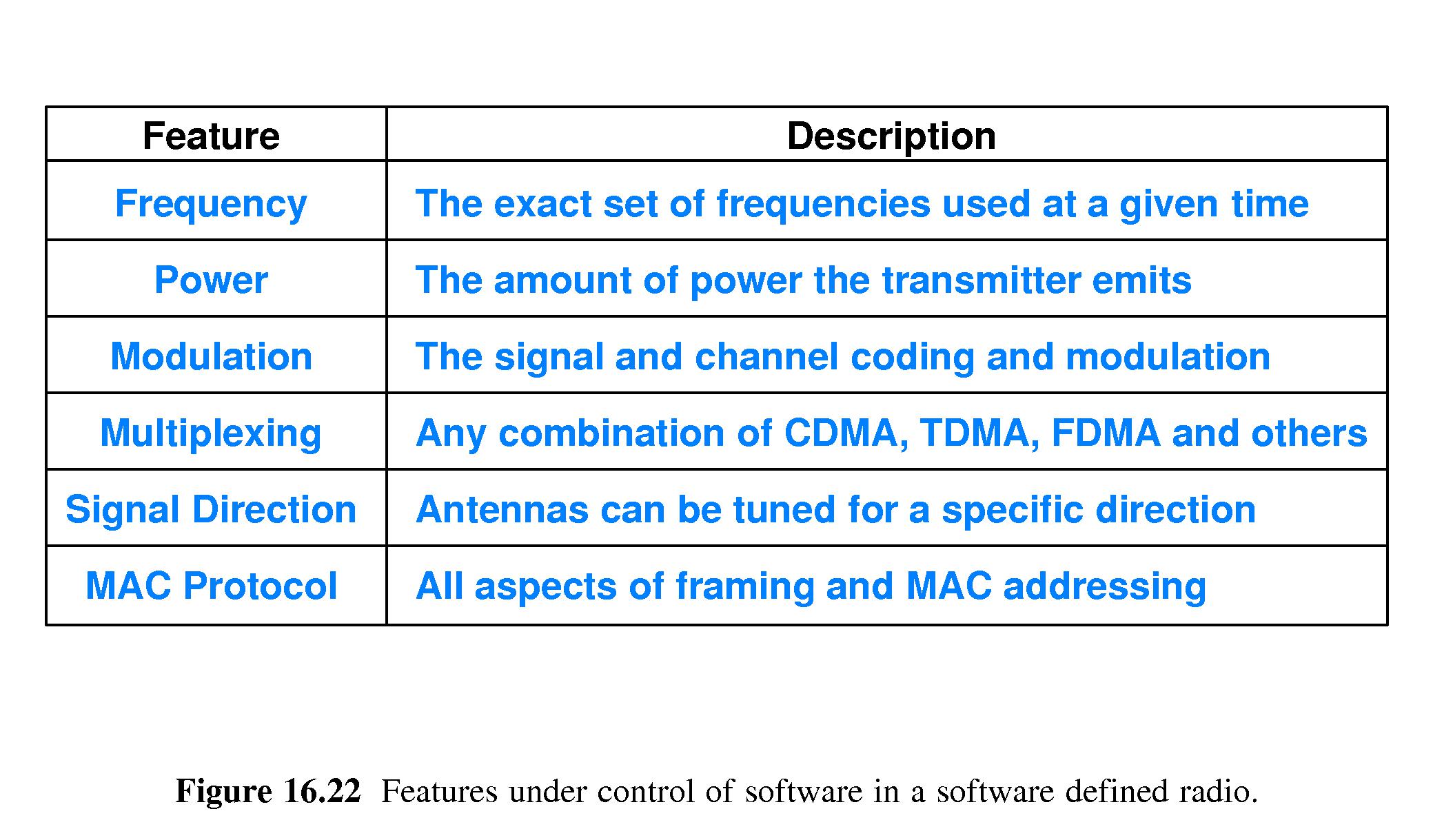(rev. Mar 25, 2017)
Notes On Chapter Sixteen
-- Wireless Networking Technologies
- 16.0 Study Guide
- Know that PANs are implemented with Bluetooth, Infrared,
and ZigBee standards and technology.
- Be aware that there are many IEEE 802.11x standards for
wireless networks
- Know what spread spectrum technology is, and advantages gained by
utilizing it
- Understand how basic service sets (BSSs) interact
with access points (APs) in a wireless LAN, and how APs connect up
to wired sections of the LAN.
- Know that WiMax is a wireless networking technology that
has many potential uses as both an access and interconnect technology.
- Be able to list some of the specific ways that WiMax can be used for
access and/or interconnect
- Have basic understanding of cellular architecture - for example,
mobile switching centers, wired connections, antennae, cells,
and handoffs.
- Some familiarity with the history of cellular technology, including knowledge
of capabilities associated with the so-called four generations.
- 16.1 Introduction
- This chapter is about wireless technologies
- There is a multiplicity of them
- 16.2 A Taxonomy of Wireless Networks
- Local Area Networks (LANs)
- Metropolitan Area Networks (MANs)
- Wide Area Networks (WANs)
- Personal Area Networks (PANs)
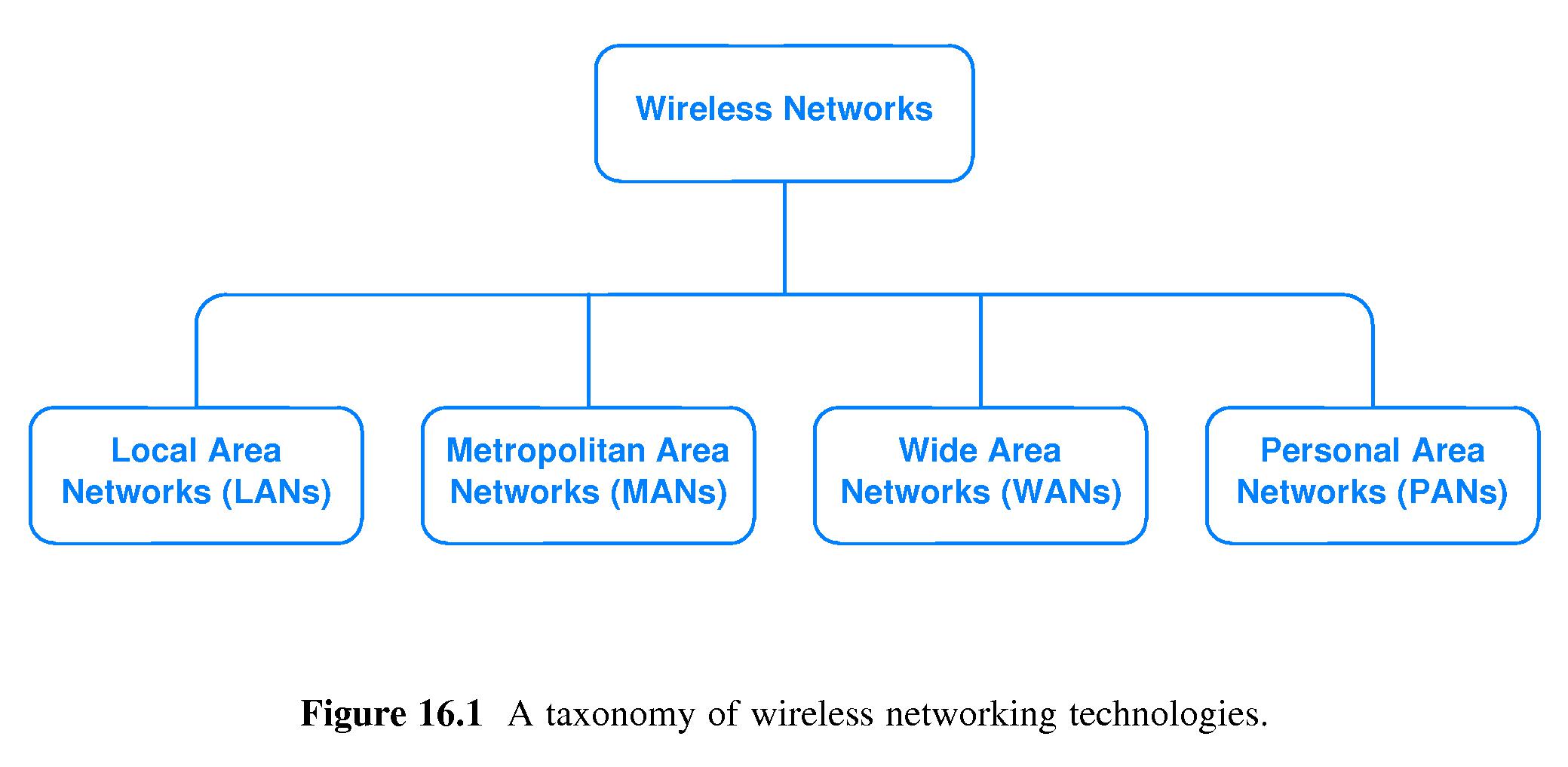
- 16.3 Personal Area Networks
- Examples of PAN technology uses:
- Categories:
- Bluetooth - e.g. headset-to-phone, computer-to-keyboard
- InfraRed - e.g. controller to entertainment system
- ZigBee - e.g. electric appliance to Smart Grid
- ISM wireless (frequencies reserved for Industrial Scientific and
Medical devices)

- 16.4 ISM Wireless Bands Used by LANS and PANS
- "not licensed to specific carriers ... broadly available for products"
- 902-928 MHz
- 2.4-2.84 GHz
- 5.725-5.850 GHz
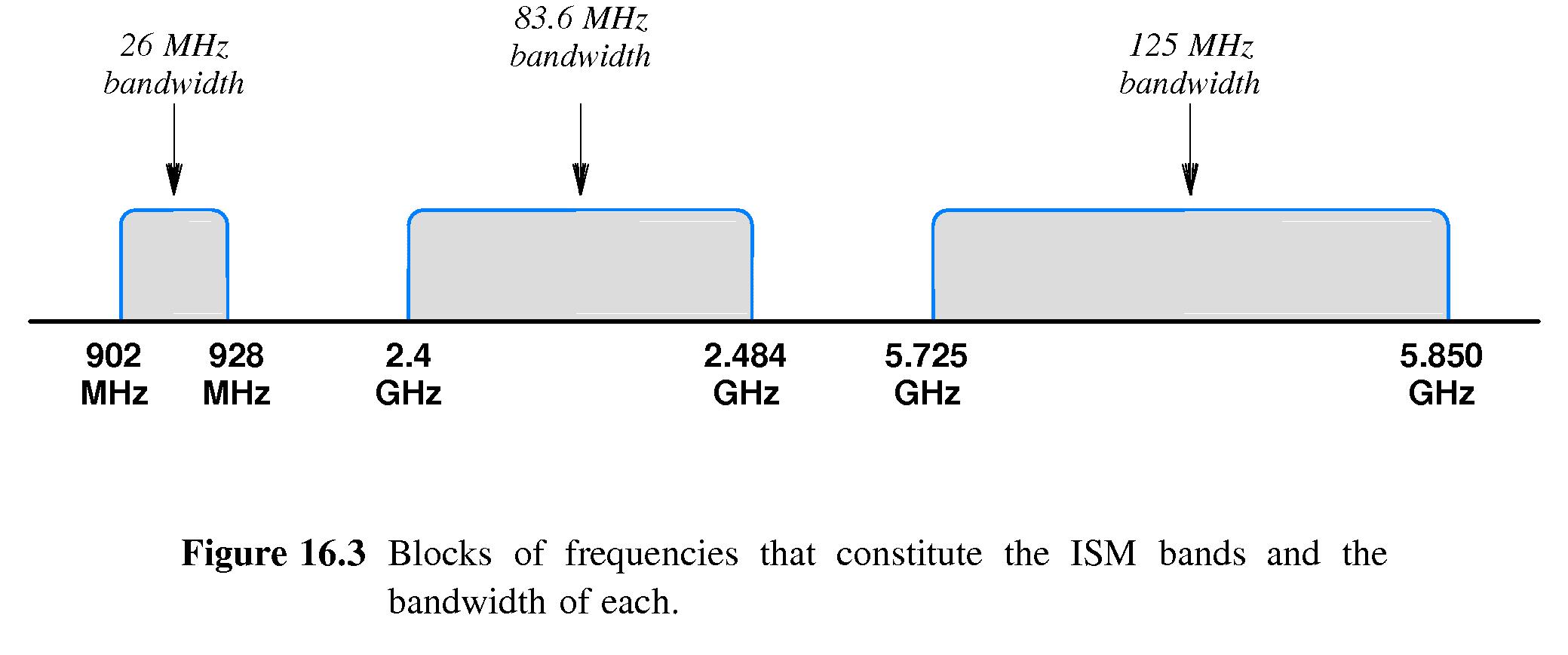
- 16.5 Wireless LAN Technologies and Wi-Fi
- IEEE provides most standards for wireless LANs (802.11)
- IEEE Standards that fall under the "WiFi Alliance"
certification organization:
- 802.11
- 802.11b
- 802.11g
- 802.11n
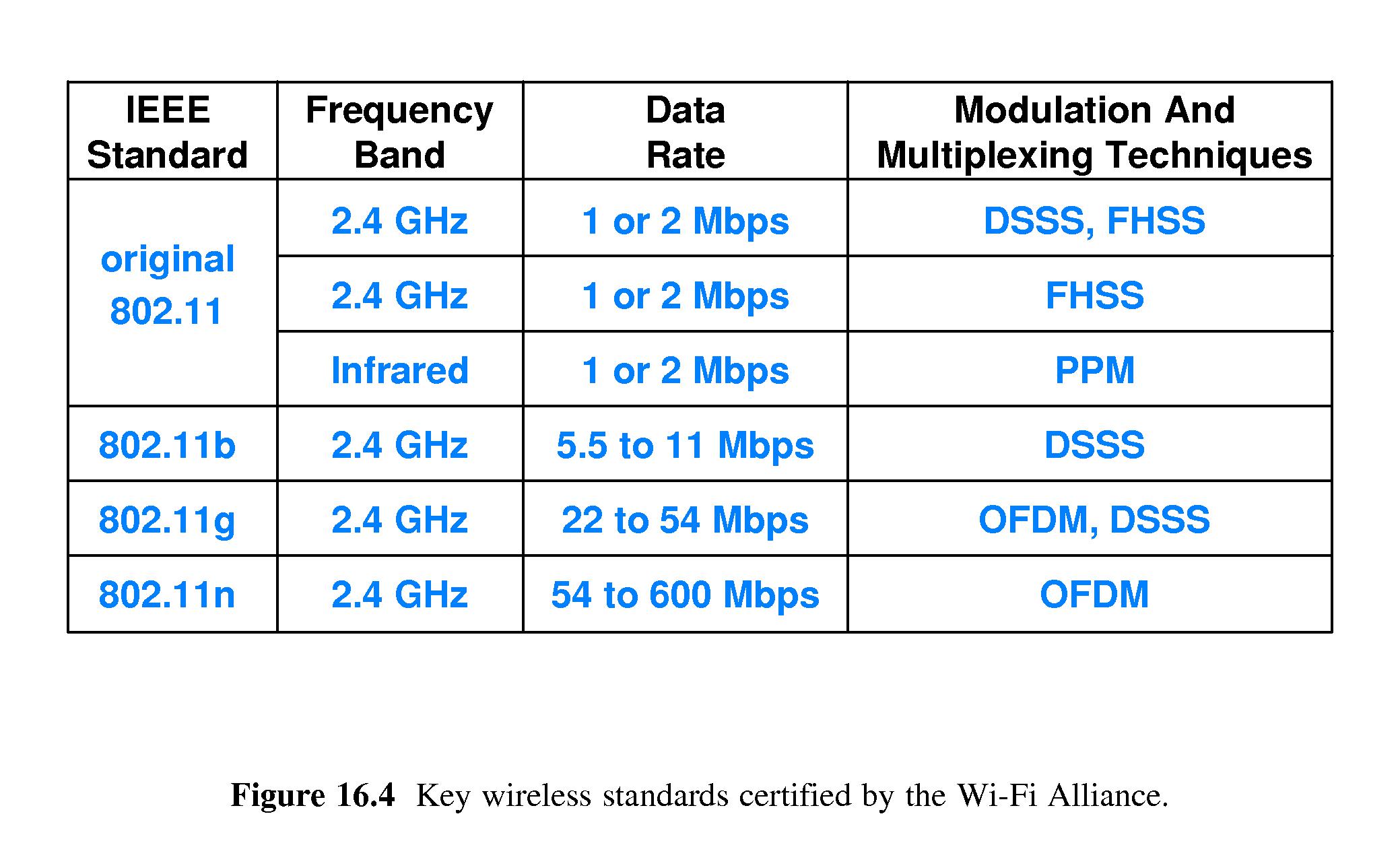
- 16.6 Spread Spectrum Techniques
- Advantages: increased performance and noise immunity
- Spread Spectrum uses multiple frequencies to send data
- Sender spreads data across multiple frequencies and receiver
recombines it.
- Three Key Multiplexing Techniques
(The text describes them only very minimally.):
- DSSS: Direct Sequence Spread Spectrum - similar to CDMA
- text says it has good performance
- FHSS: Frequency Hopping Spread Spectrum - use
of a sequence of frequencies
- text says it makes transmission more immune to noise
- OFDM: Orthogonal Frequency Division Multiplexing
- band divided into many non-interfering carriers
- text says it offers the greatest flexibility
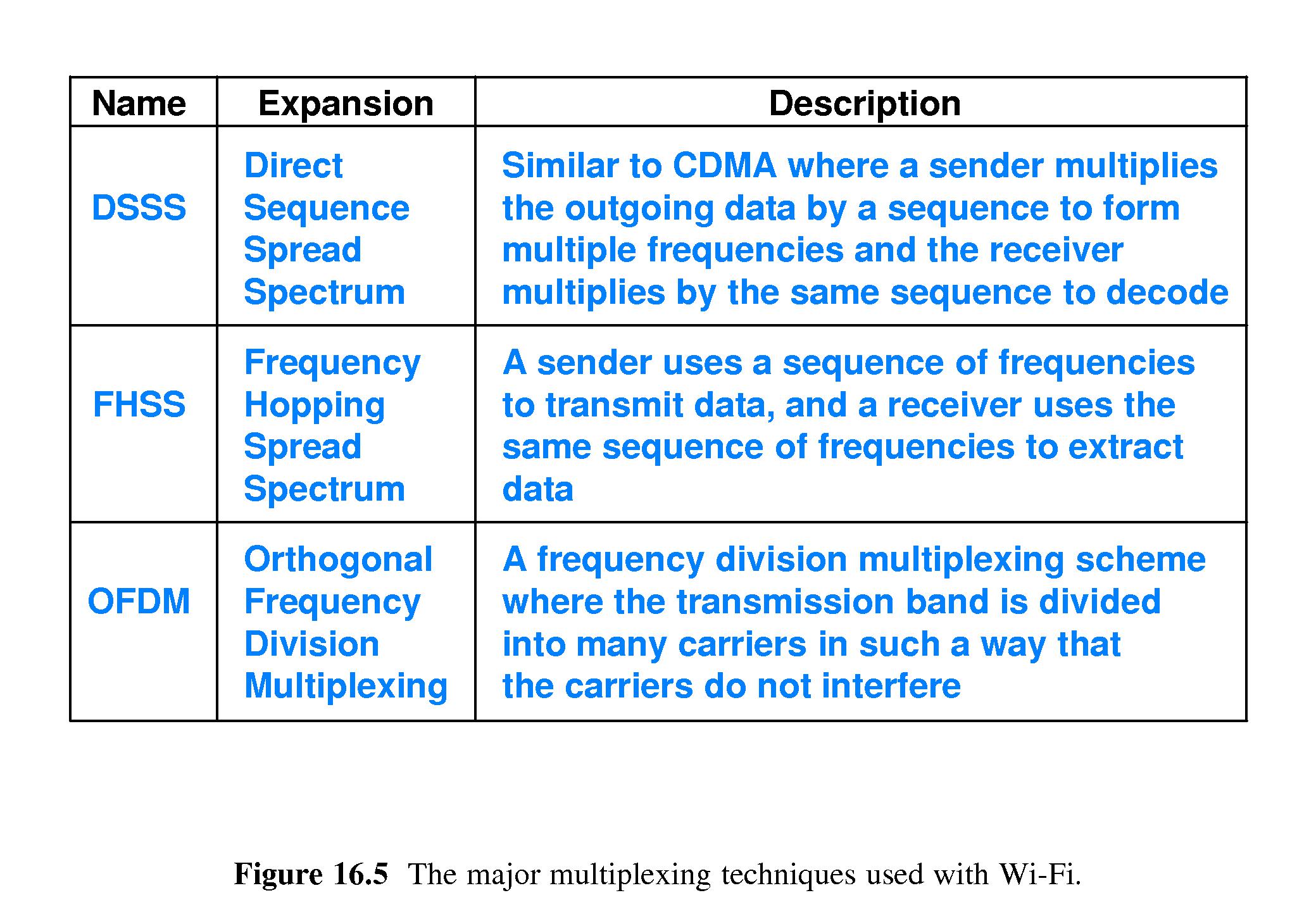
- 16.7 Other Wireless LAN Standards
- 802.11a: The first variant of 802.11 created to improve speed;
no longer popular
- 802.11e: improved quality of service, i.e. low jitter
- 802.11h: like 802.11a with control of spectrum and power
- 802.11i: enhanced security, Advanced Encryption Standard;
full version is WPA2
- 802.11k: will provide radio resource management,
including transmission power
- 802.11p: Dedicated Short-Range Communication (DSRC)
among vehicles on a highway and vehicle-to-roadside
- 802.11r: Improved roaming without loss of connectivity
- 802.11s: proposed for a mesh network in which
a set of nodes automatically form a network and pass packets
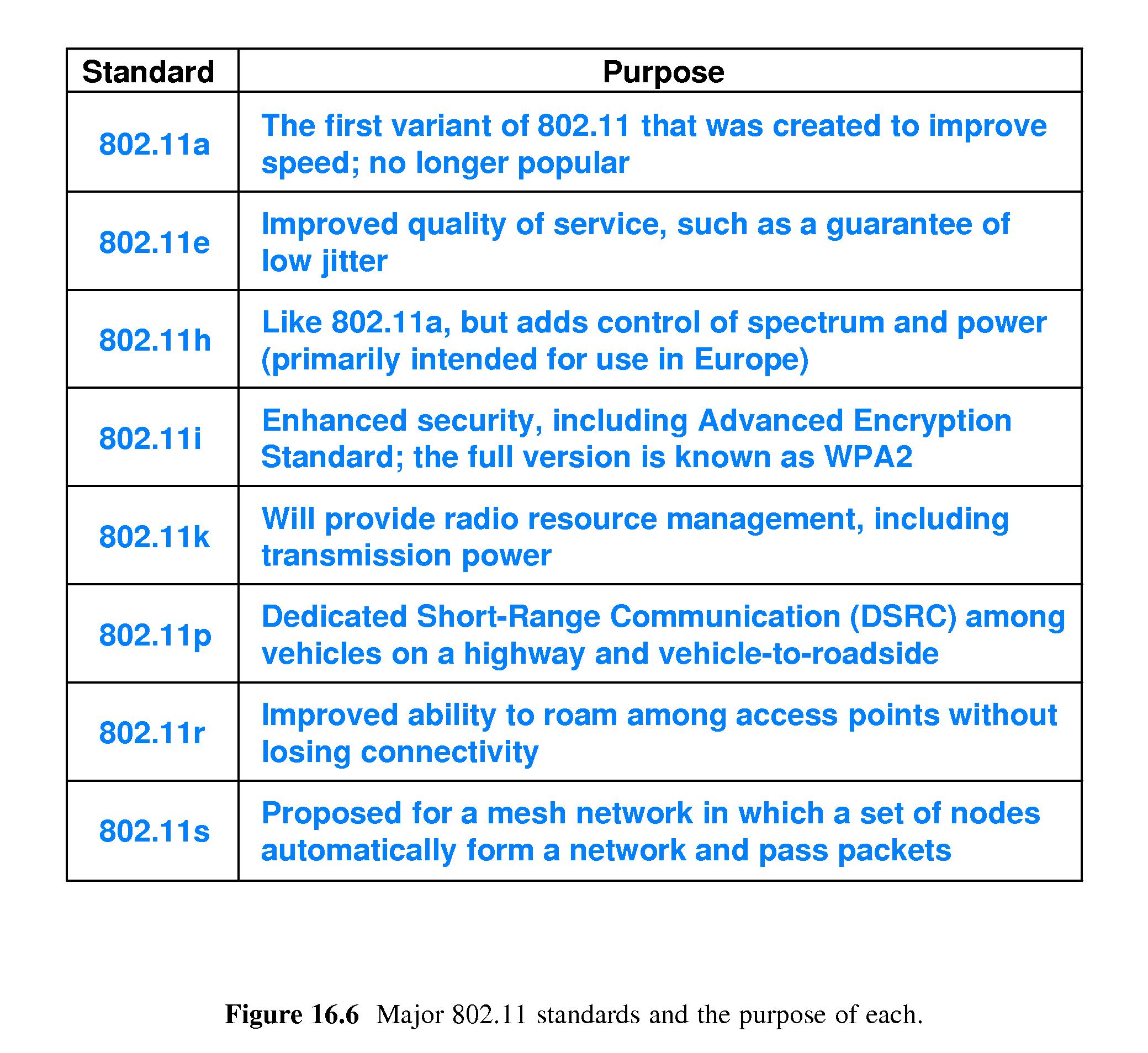
- 16.8 Wireless LAN Architecture
- Characteristics of an Infrastructure Architecture:
- See figure 16.7
- wireless hosts: computers that communicate using a
wireless network
- access point: aka base station - typically a
wireless host communicates with an access point and the
access point relays all packets.
- switch or router: an interconnect mechanism used
to connect access points - typically access points and switches
or routers are connected by a twisted-pair Ethernet.
- Basic Service Set (BSS): the set of computers within
range of a given access point.
- It is possible to have an Ad Hoc Wireless Network in which
wireless hosts communicate with each other without relying on an
access point. This architecture is not common.
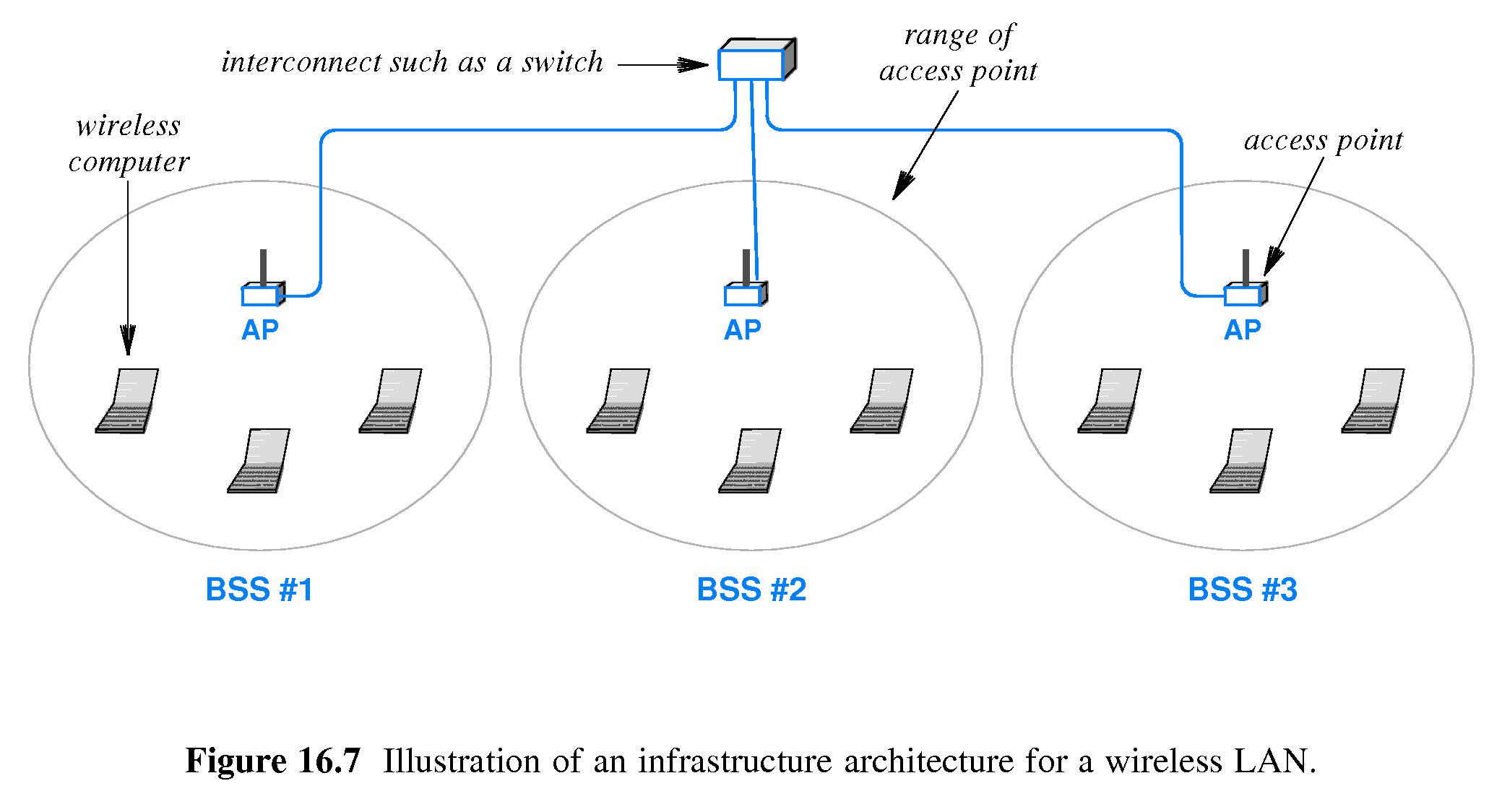
- 16.9 Overlap, Association, and 802.11 Frame Format
- See figure 16.8
- So that there will not be dead zones there must be
overlaps - areas where a wireless host can reach
more than one access point.
- According to 802.11, a wireless host must associate with (send
frames to) only one access point.
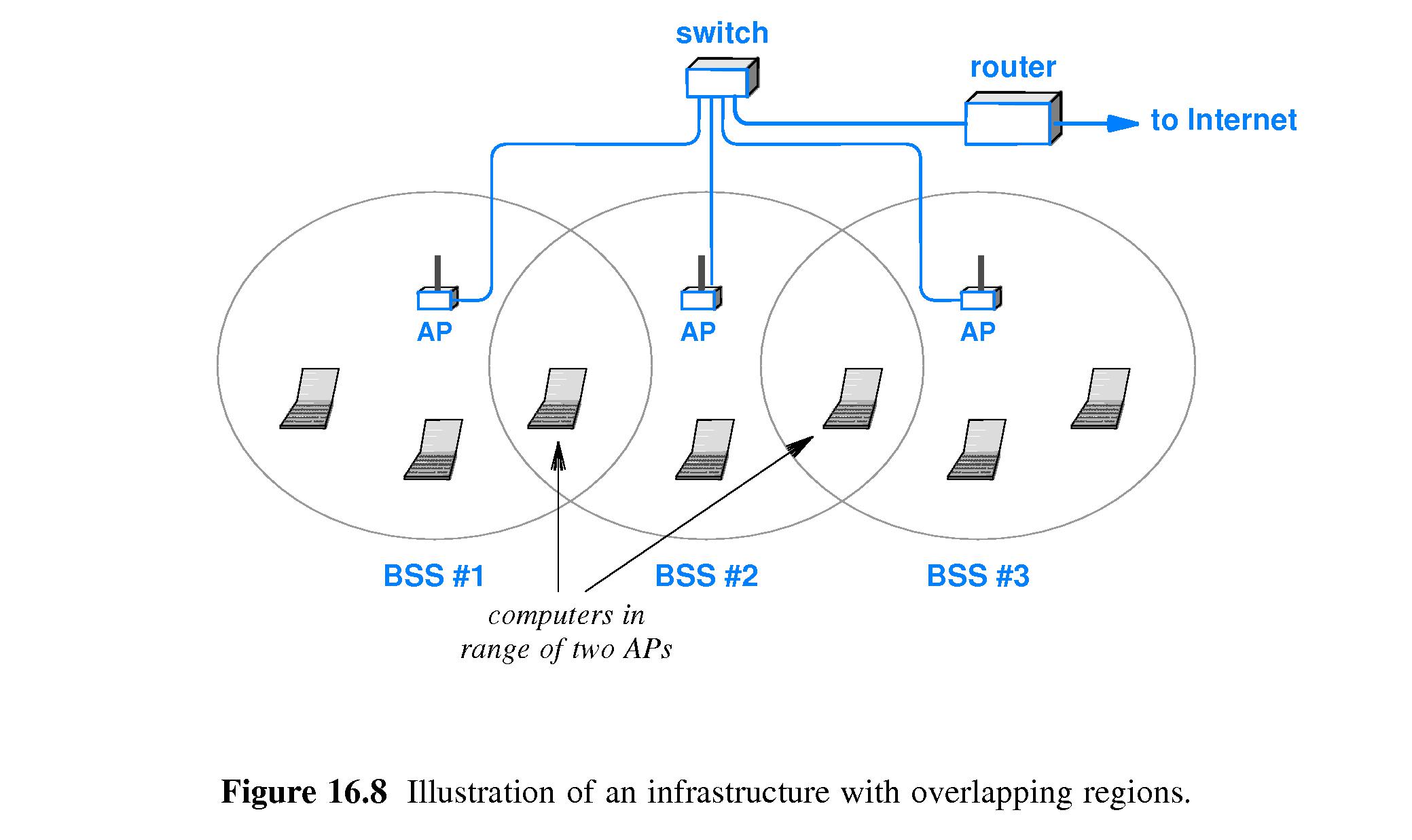
- In an infrastructure architecture the 802.11 frame carries the
MAC address of the target access point, and also the MAC address of
the target router connected to the access point.

- 16.10 Coordination Among Access Points
- Some types of access points coordinate to insure smooth handoff as a
wireless computer moves from the region reached by one access point
to another.
- Other types of access points just operate independently and rely on
the ability of a wireless host to change the access point to which
it is associated.
- 16.11 Contention and Contention-Free Access
- General Approaches are:
- Point Coordinated Functions (PCF)
- Distributed Coordinated Functions (DCF)
- With PCF the access point controls stations in the BSS to make sure
they do not interfere, for example by assigning a separate frequency
to each station. This method is seldom, if ever, used.
- With DCF, each station in the BSS runs a random access protocol like
Carrier Sense Multi-Access with Collision Avoidance (CSMA/CA).
- In CSMA/CA, a sender begins with a short ready-to-send (RTS)
message and the access point responds with a short clear-to-send
(CTS) message. Then the sender sends its
data and the access point responds with an acknowledgement (ACK).
- The 802.11 standard specifies minimum delays between these messages.
- If no ACK arrives the sender employs a back-off strategy.
- Collision detection is not part of the scheme. It is difficult to
distinguish collisions from weak signals and interference.
- Conditions vary and some wireless networks must depend heavily on
retransmission - others hardly at all.
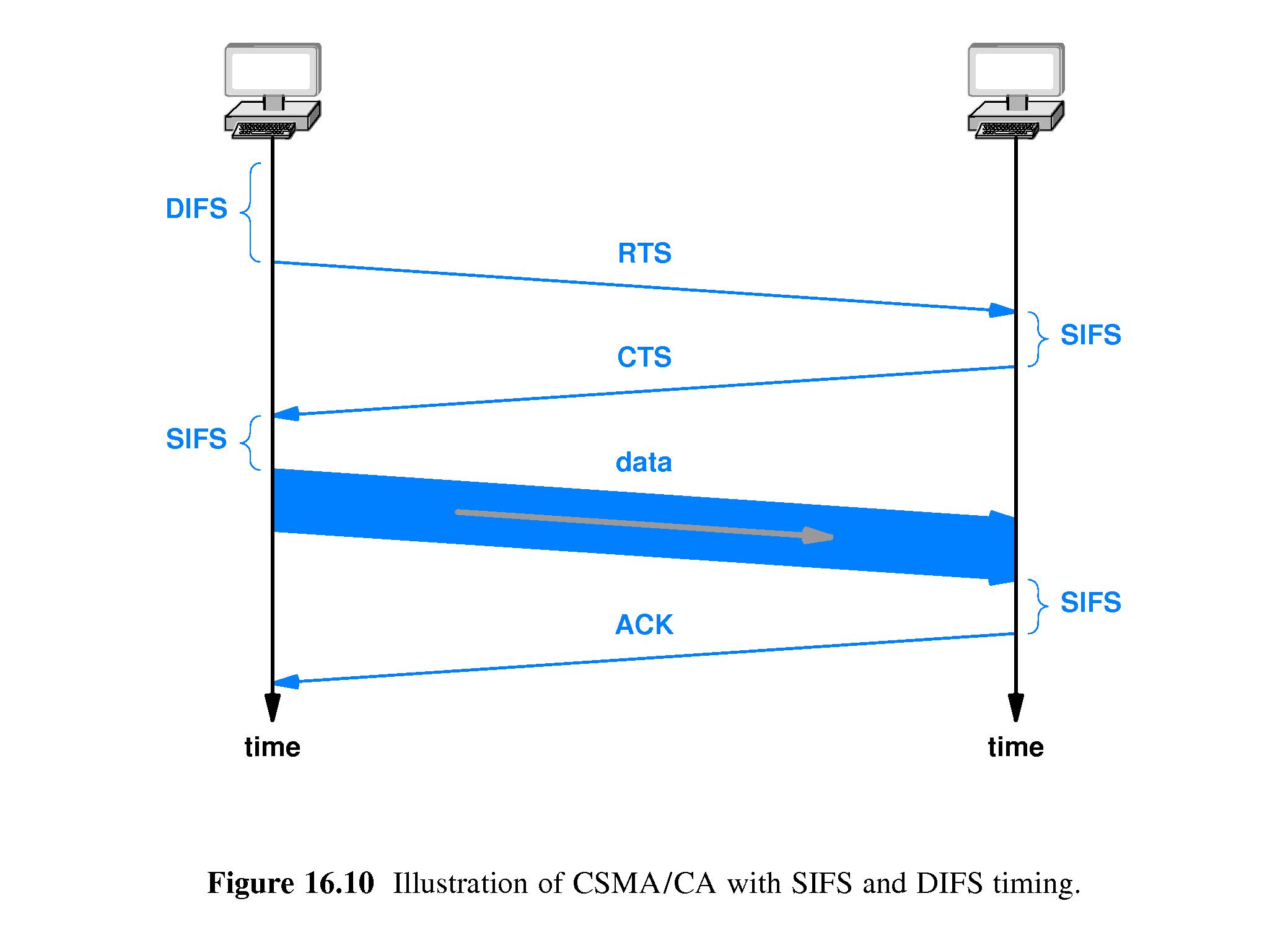
- 16.12 Wireless MAN Technology and WiMax
- Not too many MAN technologies have caught on.
- WiMax is one MAN technology that seems to have a lot of potential
- WiMax = World-wide Interoperability for Microwave Access = 802.16
- Fixed WiMax (802.16-2004, 802.16d) DOES NOT provide for handoff
among access points.
- Mobile WiMax (802.16e-2005, 802.16e) DOES provide handoff among
access points and can be used with mobile computers, phones and other
mobile devices.
- A WiMax cell has a range of 3-10 Km
- WiMax can provide data rates of 10-70 Mbps
- Applications include:
- Last Mile Internet Access - alternative to DSL or cable modem
- General-purpose interconnection within a city
- Backhaul - e.g. service provider central tower to remote cell
towers (high data-rate LOS frequencies).
- Unified data and telecommunications access
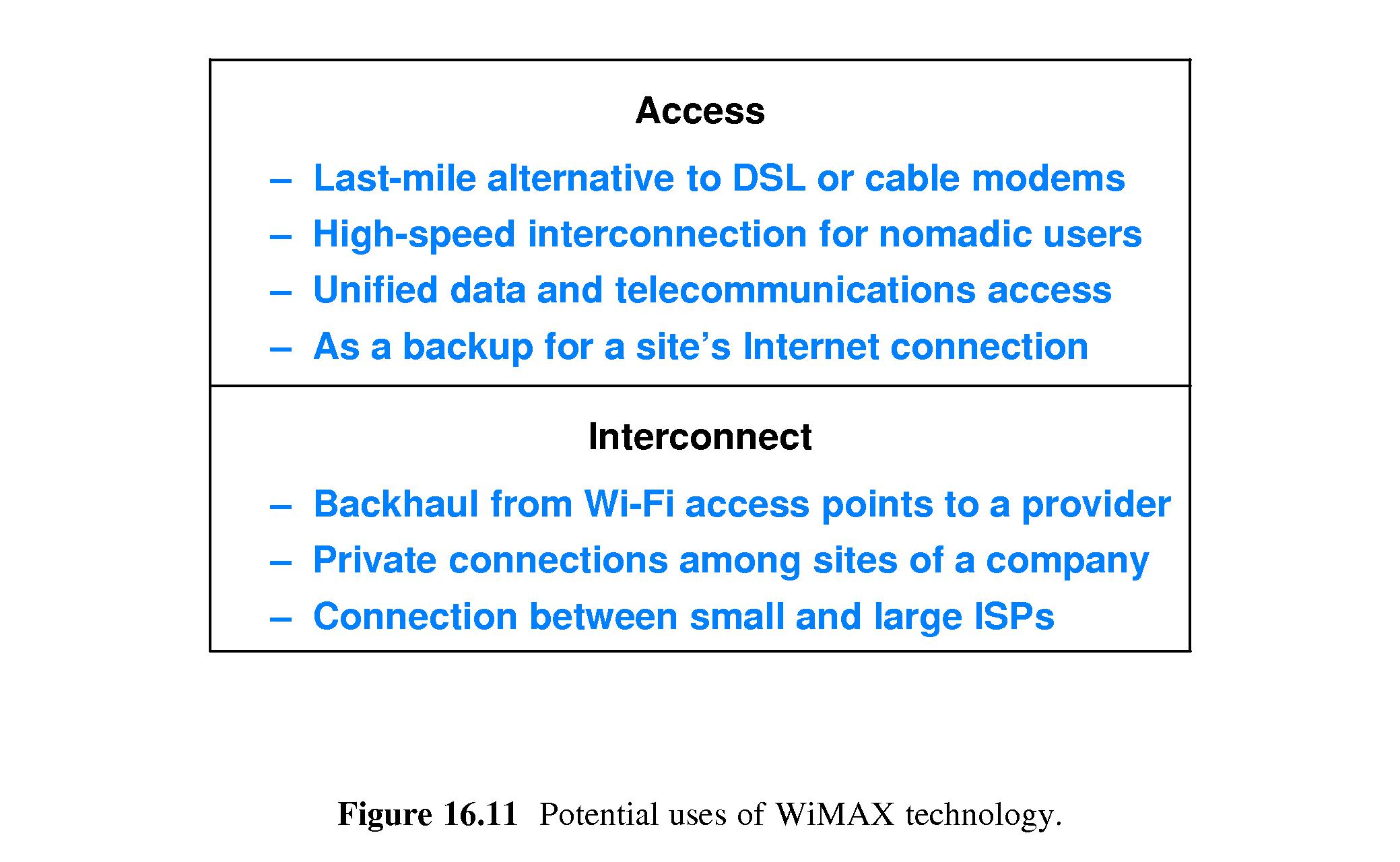
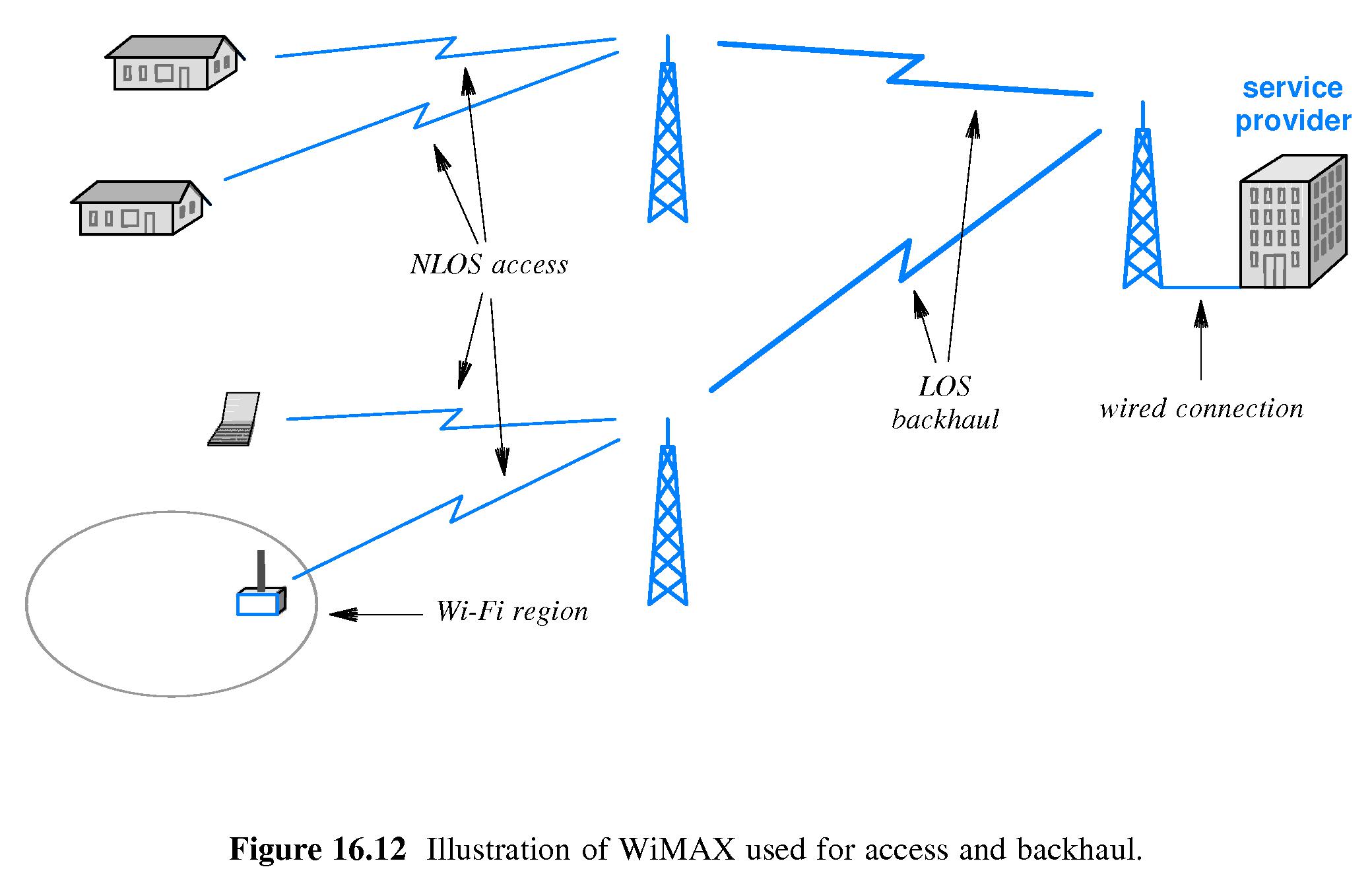
- 16.13 PAN Technologies and Standards
- There are various wireless PAN standards
- Bluetooth: high frequency, short distance, master-slave, 721 Kbps
- Ultra Wideband (UWB): saves power by spreading across many
frequencies, goes through walls, up to 500 Mbps
- Zigbee: for remote control in industry and homes, not for data, three
frequency bands and data rates up to 250 Kbps, low power consumption,
three levels of security being defined.
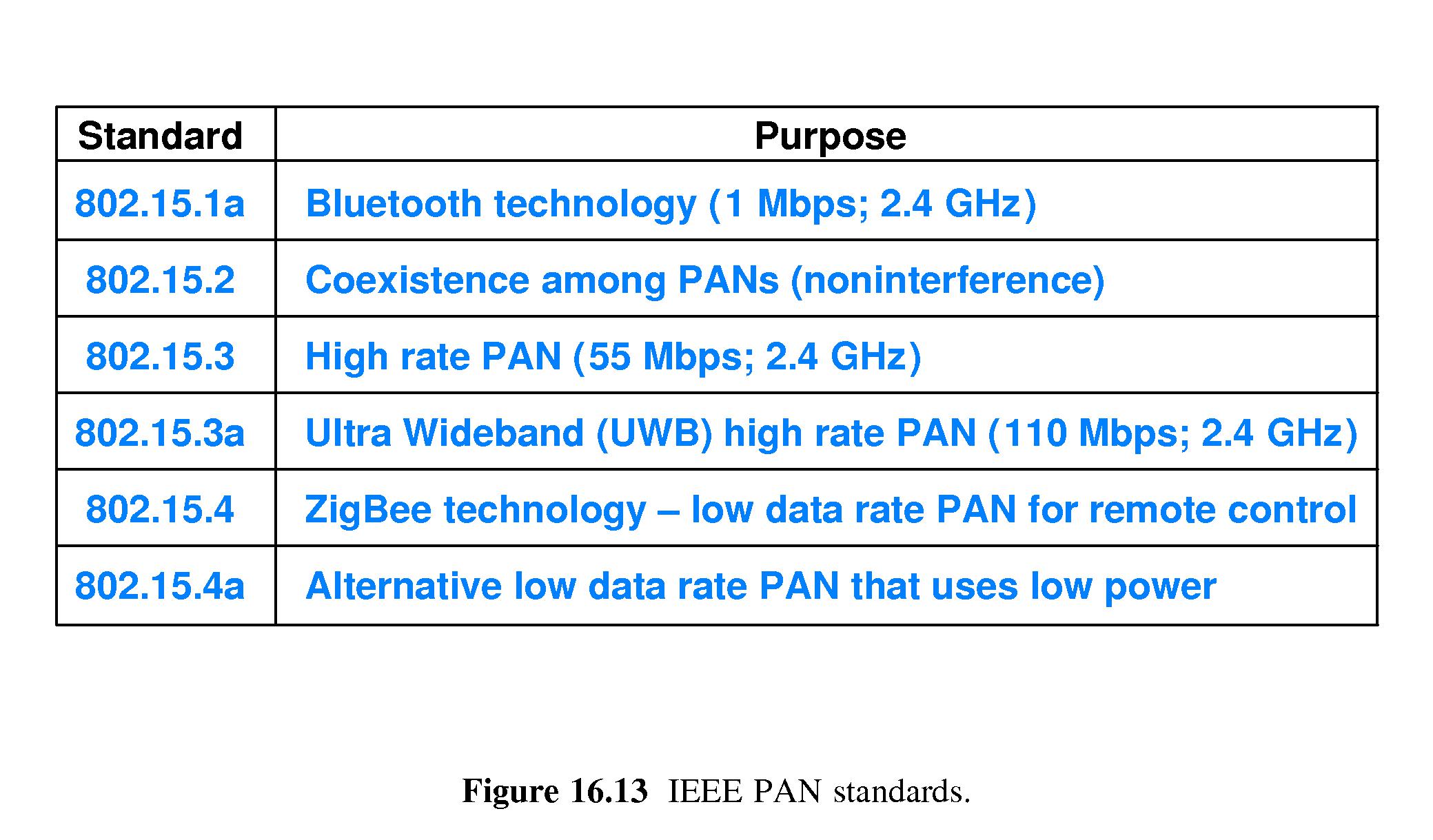
- 16.14 Other Short-Distance Communication Technologies
- InfraRED is used for remote control and low-speed data transfer - up
to about 16 Mbps
- Small RFID tags used e.g. for inventory control, sensors, and
passports can contain information that a receiver can "pull" -
passive RFID's draw power from reader's signal and active RFID's have
a battery that can last 10 years.
- 16.15 Wireless WAN Technologies
- WAN Technologies:
- Cellular communication systems, or
- Satellite communication systems
- Cellular Communication Systems
- See figure 16.14
- Cellular systems are being used more and more for data and
Internet service, in addition to voice.
- Each cell has a tower and groups of cells are connected to a
Mobile Switching Center that connects in with the
Public-Switched Telephone Network and the Internet too.
- The Centers track users and manage handoff as a user passes from
one cell to another.
- In a handoff from one group to another, two Mobile Switching
Centers are involved.
- Real cell coverage maps do not correspond to perfect honeycomb
patterns.
- Cell sizes differ between rural and metropolitan areas.
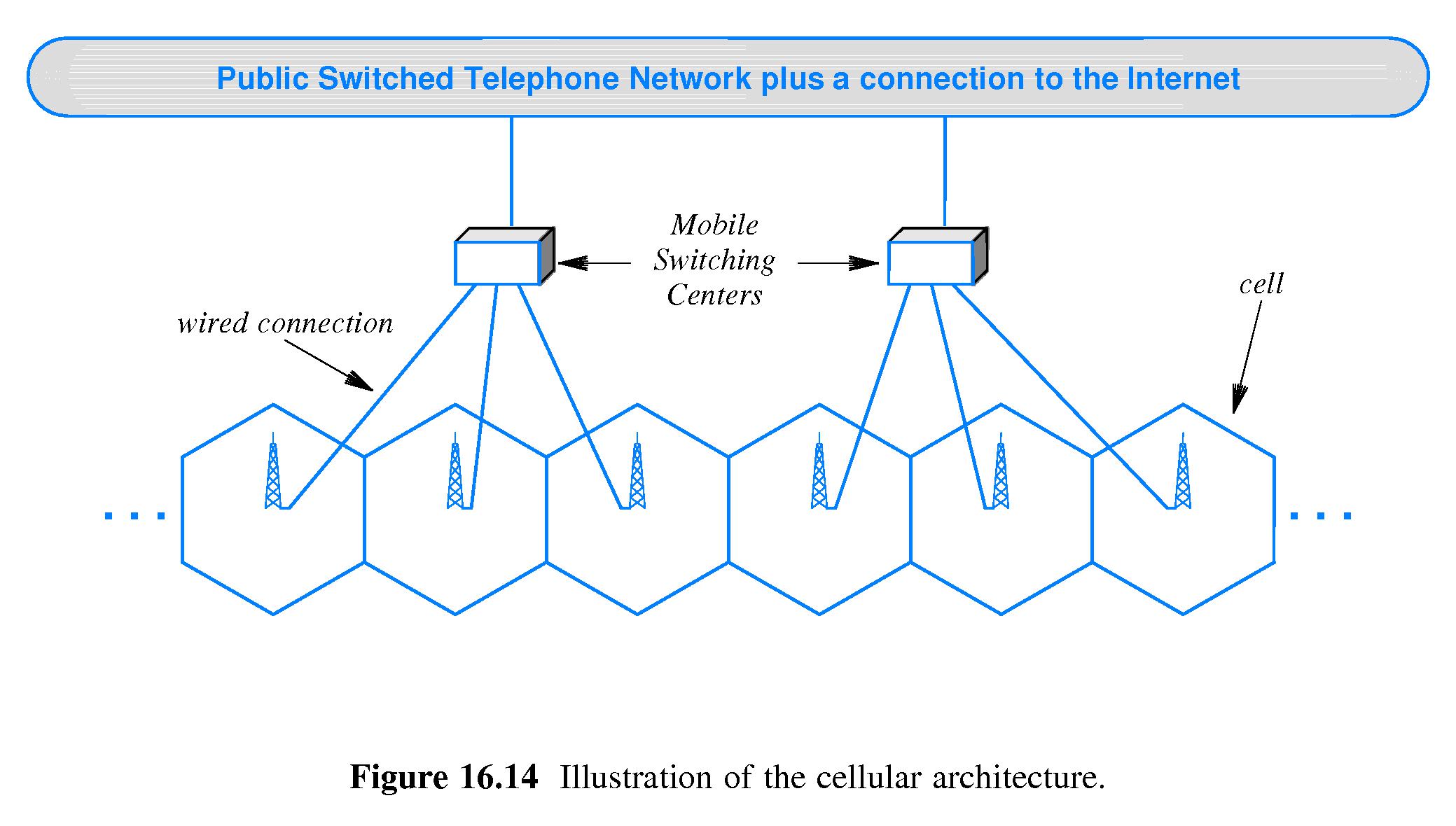
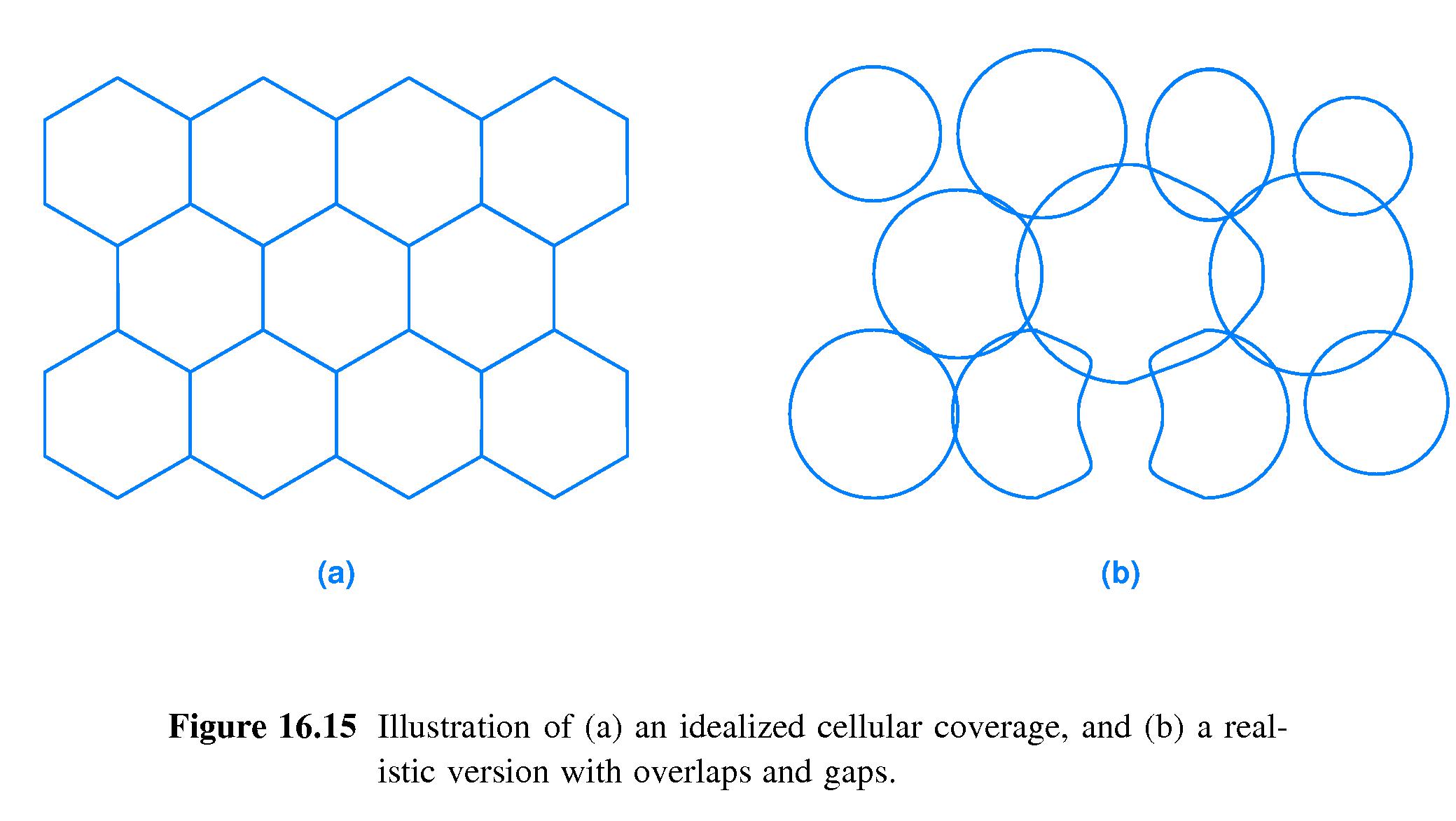
- 16.16 Micro Cells
- There may be 'micro cells' that only serve, for example,
a subset of the floors
of a high-rise apartment building.
- Some providers sell or lease micro cell devices to individuals -
a device that connects to the Internet and provides cell
service within a residence to a set of recognized devices.
(no per-minute charges.)
- 16.17 Cell Clusters and Frequency Reuse
- There are schemes for assigning frequencies to (e.g. phone) cells so
that no two adjacent cells use the same frequency, This lessens
problems with interference.
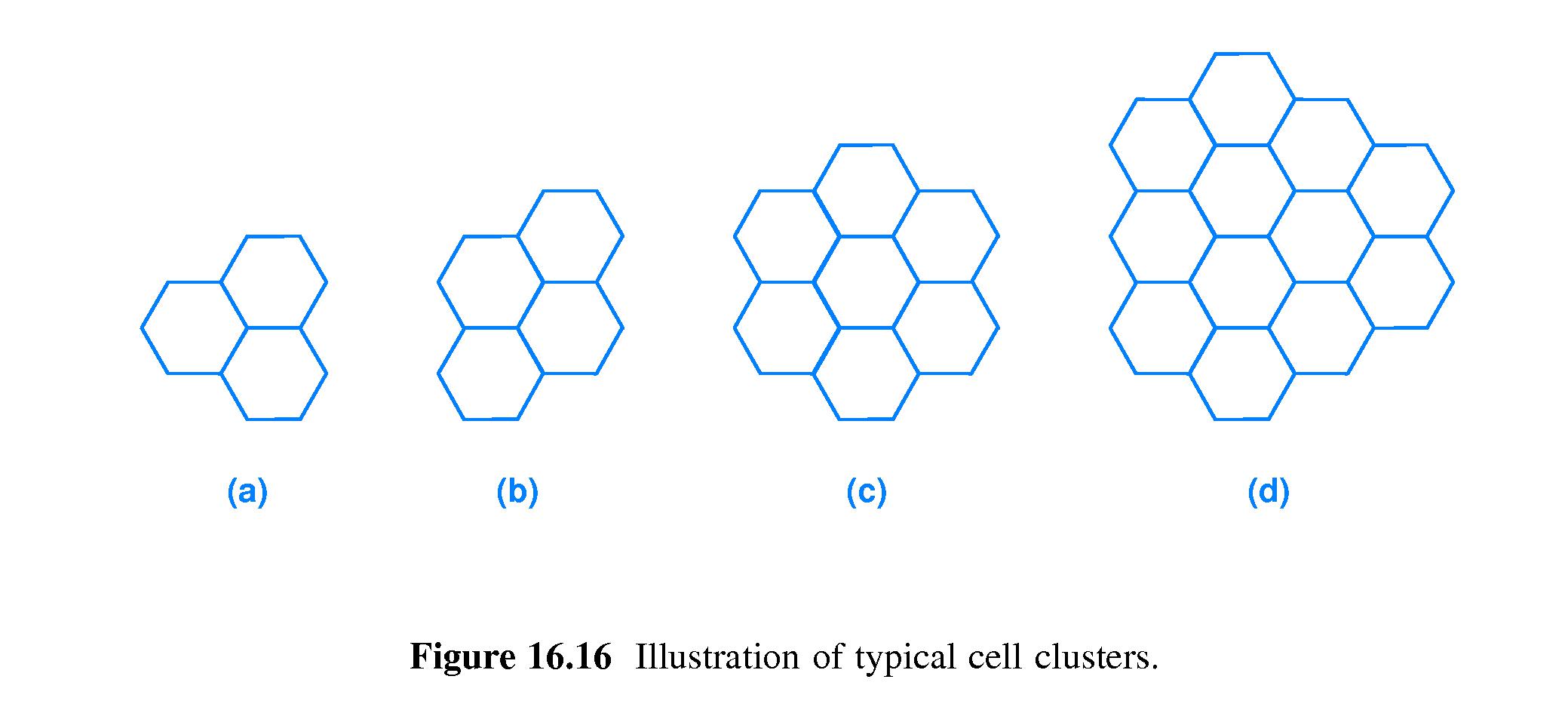
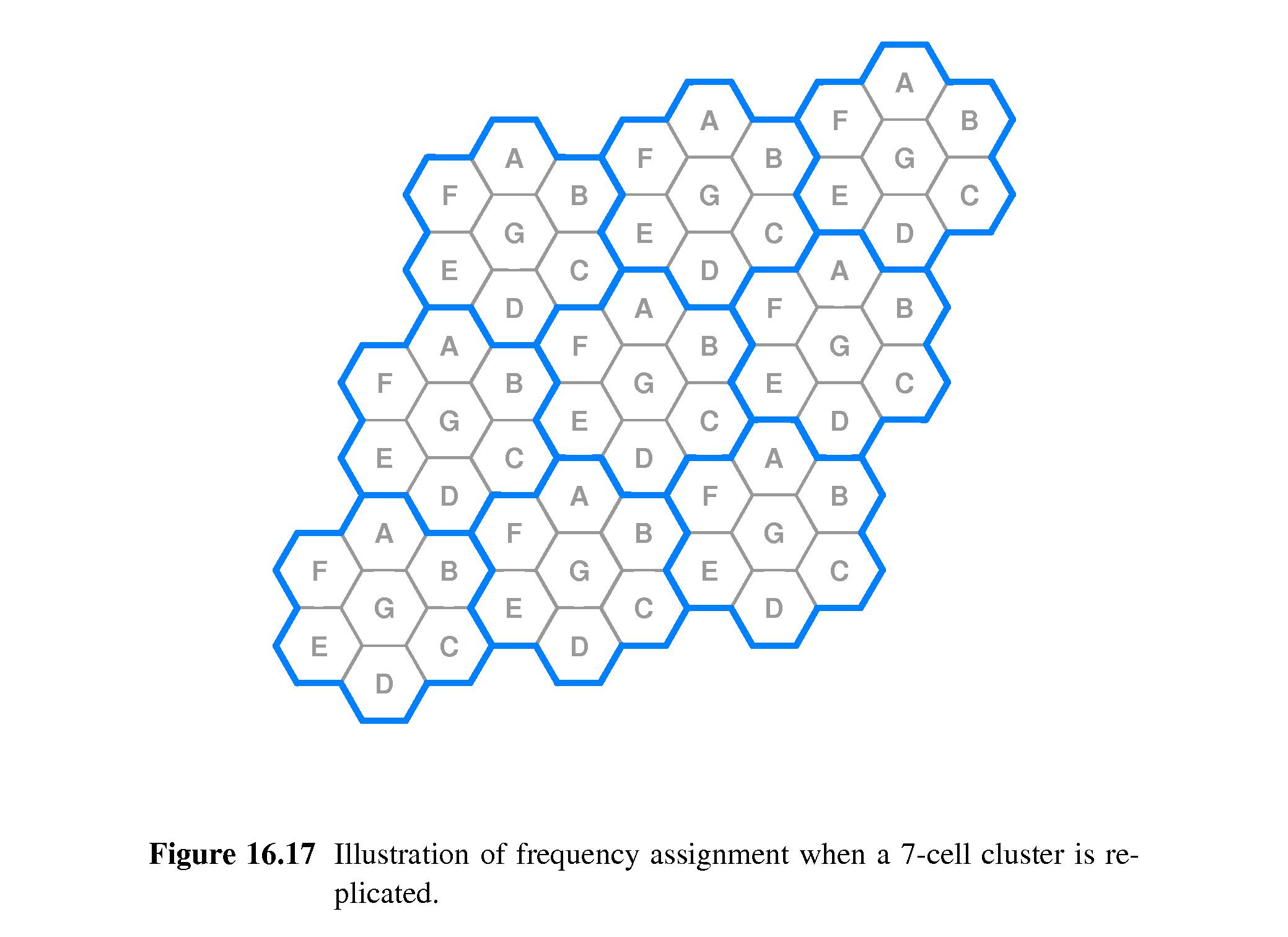
- 16.18 Generations of Cellular Technologies
- 1G: 1970's through '80's - analog voice
- 2G: early 1990's to present - digital voice
- 3G: starting in the 2000's - addition of high-speed data services for
web-browsing, photo-sharing, and the like
(download rates of 400Kbps to 2Mbps)
- roaming over N.A. Japan & Europe
- 4G: starting in 2008 - support for real-time media like TV &
high-speed video downloads - support for multiple connection
technologies, e.g. WiFi and satellite with phone choosing
best service dynamically. Designed for the Internet - uses
packet switching.
- There is a wide variety of implementation strategies.
- Proposals for 5G call for higher data rates, reduced latency, and more capacity.
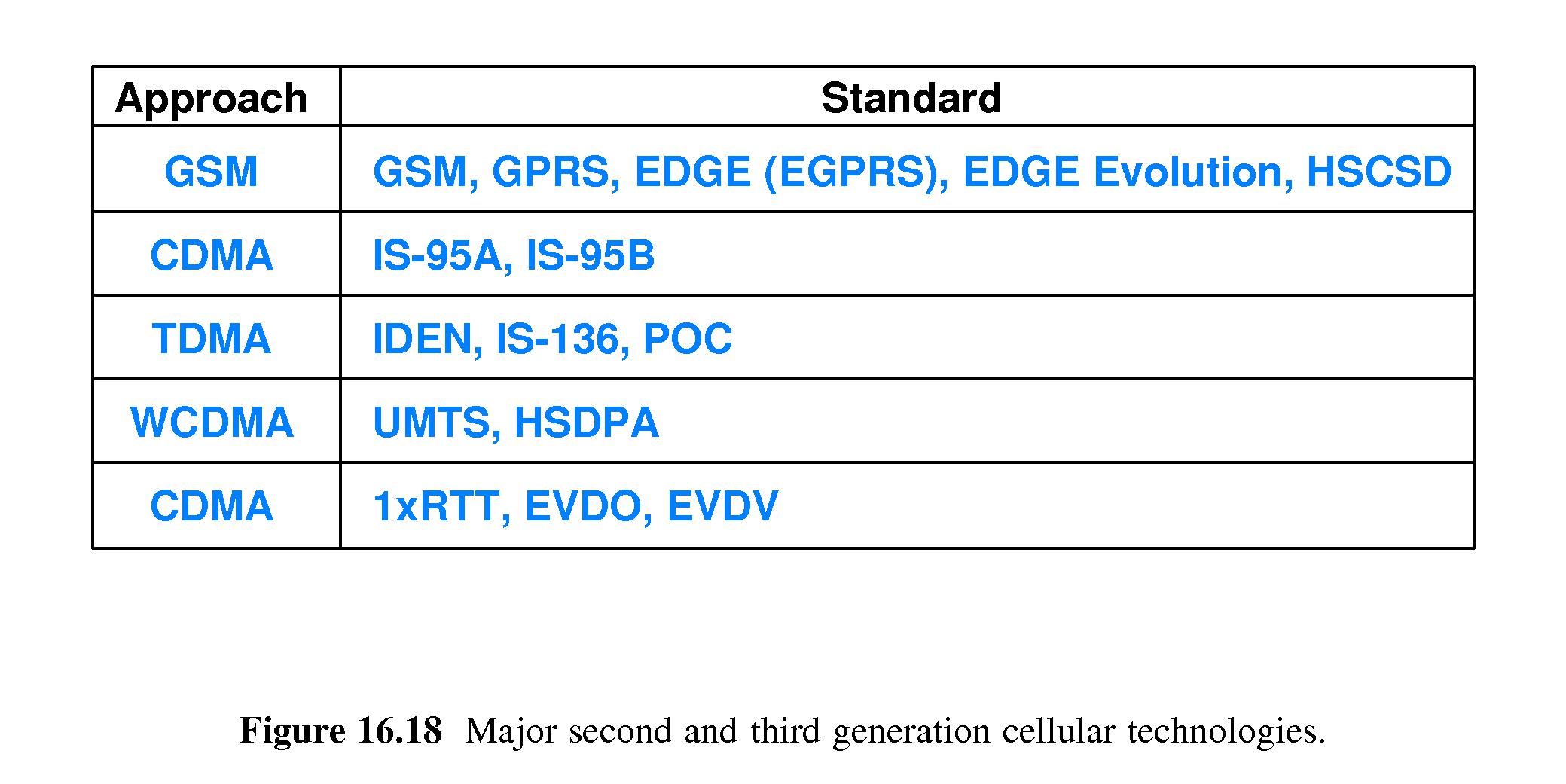
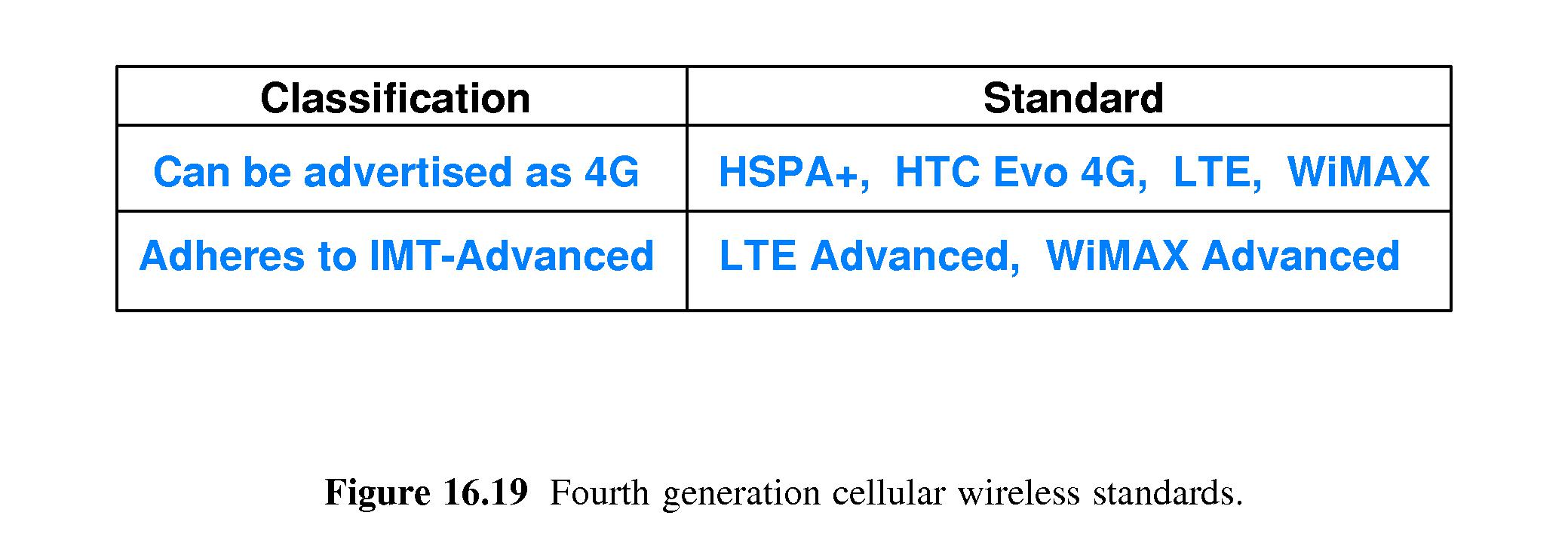
- 16.19 VSAT Satellite Technology
- Antennae with parabolic reflectors cause incoming energy to
converge at a focal point.
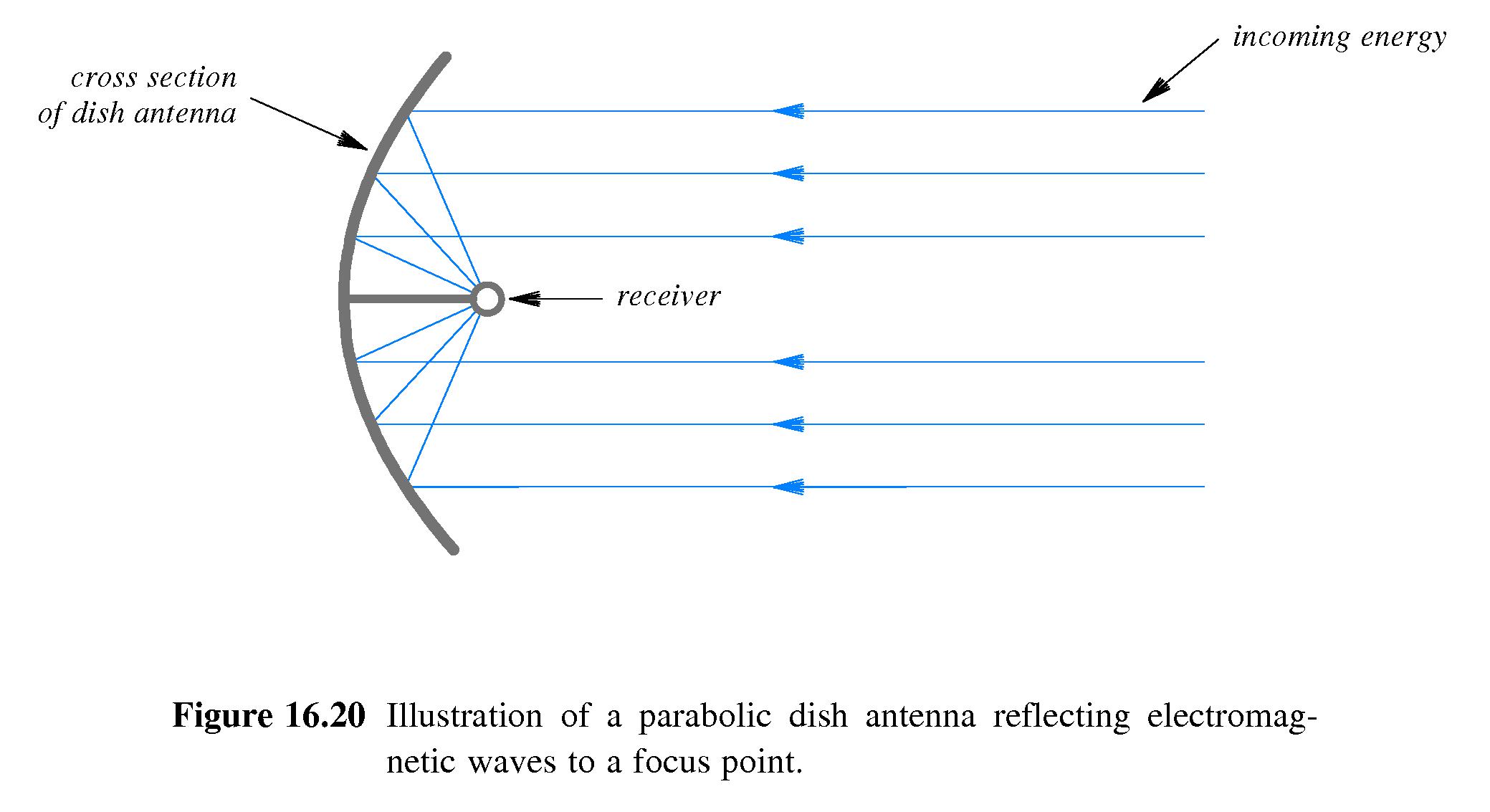
- Early receivers used large antennae (e.g. 3m+ diameter)
- Very Small Aperture Terminal (VSAT) technology allows diameters more
in the 1m range.
- VSAT is used to link businesses, to download entertainment, and for
Internet access.
- There are three frequency ranges offered with differing footprint,
signal strength and sensitivity to atmospheric effects (e.g. rain).
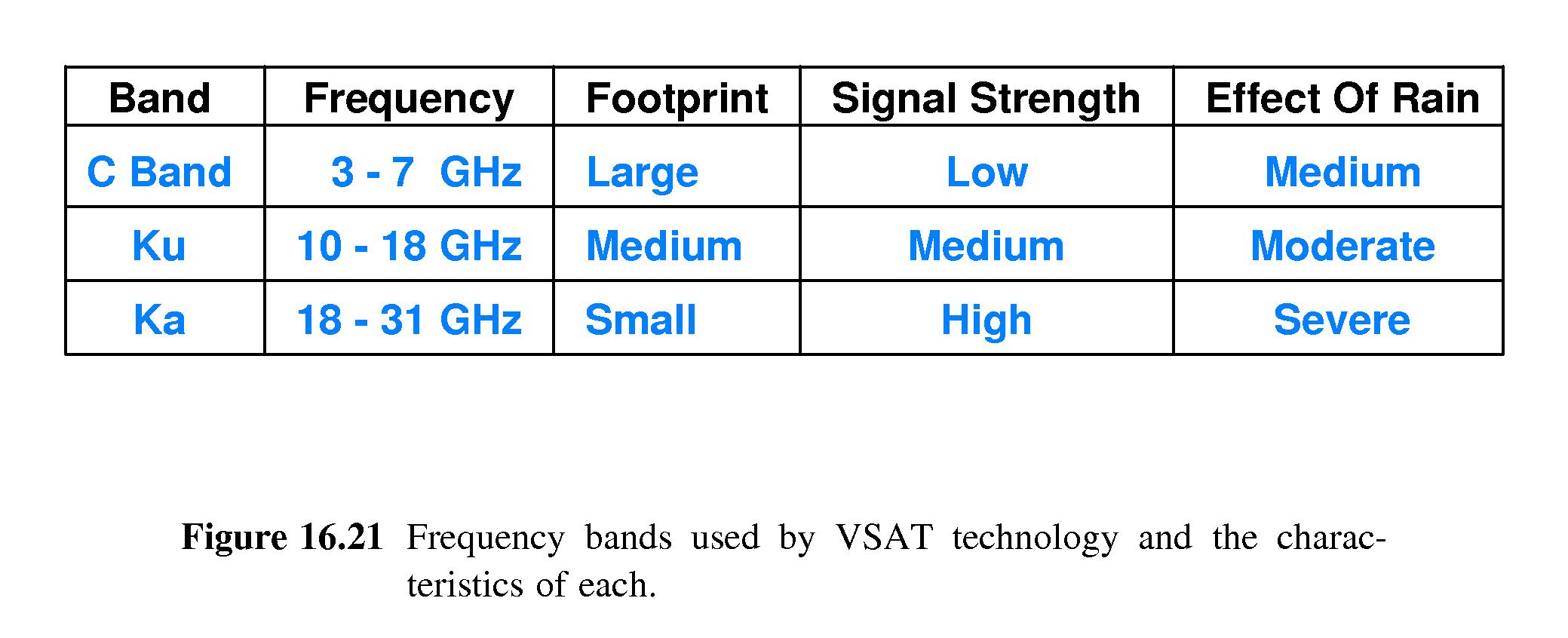
- 16.20 GPS Satellites
- GPS satellites provide accurate time and location information
- Such information is used increasingly in mobile networking - e.g.
location-based services.
- A receiver can determine its distance to three of the satellites,
and from that work out its position on the earth.
- Key Features:
- Accuracy between 20 and 2 meters (military version are even better)
- 24 total satellites orbit earth
- Satellites in six orbital planes
- Provides time synchronization used in some communication networks
- 16.21 Software Defined Radio and the Future of Wireless
- SDR is a technology that can help deal with the complexity arising
from the wide variety of wireless technologies.
- A software radio is a device that uses tunable analog filter chips,
digital signal processor chips, and multiple antenna management to
dynamically control:
- frequencies used for receiving and transmitting
- transmitter power
- channel coding and modulation scheme(s) in use
- multiplexing scheme(s) in use
- direction to which various antennae are tuned
- all aspects of MAC framing and MAC addressing
- The US military uses software radio
- The Universal Software Radio Peripheral (USRP) and GNU Radio are
available for experimentation
- Some details have to be worked out before they appear in commercial
products - e.g. high cost and protection of other devices from
interference that might be caused by software radios.
